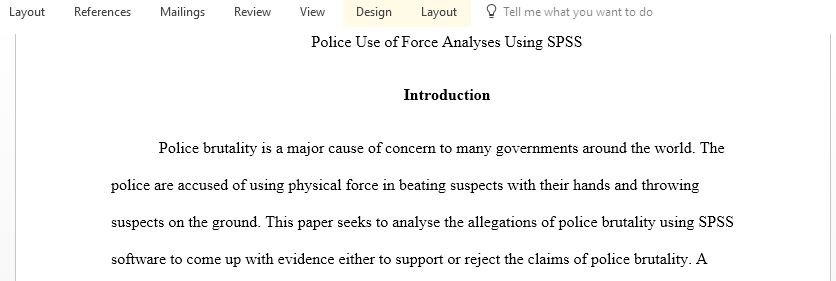Police Use of Force SPSS Output and Write-up of Findings
Topic: Police Use of Force SPSS Output and Write-up of Findings. Variables: Independent variables(cause)- Physical force used by officer – hands Physical force used by officer – suspect on ground Physical force used by officer – pepper spray Dependent variable(effect)- Police Use of force Must use SPSS! SPSS attachment and codebook is attached. Students will use SPSS to analyze data for the purpose of testing their research hypotheses, and write up the findings of their analyses. Students will conduct univariate (frequencies, mean, median, mode, range) and bivariate (correlation, crosstabs) analyses with their data. Students will submit the SPSS output of their analyses, as well as the write-up of their findings.
1. When analyzing categorical variables, you must run a crosstab.
2. When running a crosstab, the independent variable goes in the column, and the dependent variable goes in the row.
3. When analyzing nominal variables (e.g. gender and race), Phi is the correct measure of association. When analyzing ordinal variables (e.g. social class, level of education), Gamma is the correct measure of association. Important note: Identify the level of measurement for each of your variables BEFORE conducting analysis!
4. Measures of association (Phi and Gamma) tell you the strength of the bivariate relationship.
5. Phi and Gamma range in value from 0 to 1:
If the value is below .3, the strength of the relationship is weak.
If the value is between .3 and .6, the strength of the relationship is moderate.
If the value is above .6, the strength of the relationship is strong.
6. Chi square tells you whether the relationship is statistically significant.
SPSS will provide the value of Chi square and the significance level (p value). You must report both in your findings.
7. The p value tells you whether Chi square is significant. If p < .05, the relationship is statistically significant.
8. When analyzing continuous variables (e.g. age or years of service), run a correlation, not a crosstab.
9. The correlation matrix will include a Pearson’s r and a significance level (p value). You must report both in your findings.
10. Peason’s r is the measure of association for continuous variables, it tells you the strength of the relationship. Like Phi and Gamma, r ranges in value from 0 to 1.
If the value is below .3, the strength of the relationship is weak.
If the value is between .3 and .6, the strength of the relationship is moderate.
If the value is above .6, the strength of the relationship is strong.
Answer preview for Police Use of Force SPSS Output and Write-up of Findings
Access the full answer containing 605 words by clicking the below purchase button.

